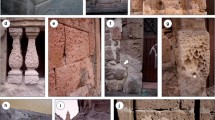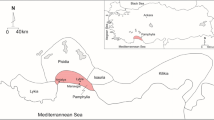Abstract
Stones have been used as a construction material in Greece, since the 7th century B.C. Most of the public and other important buildings in ancient greek cities were made of stones. Various types of rocks have been used, from soft rock like travertine, soft sandstone, marl limestone, etc., to hard rocks like marble, hard limestone, schist, etc. Some of these rocks, especially the soft ones, created problems of deterioration, through the time. One such a case, the deterioration of a soft sandstonten used in Ancient Abdera, N. Greece, is examined in this paper. This sandstone is a molassic origin rock, used both as a building and decorative material since the antiquity. Sampling were made both from modern quarries (fresh rock) and the ancient settlement. The mineralogy, the granulometry, the physical and technical properties, the salt resistance and durability of the rock were examined in order to elucidate the possible causes of its deterioration in construction works.
From the results obtained, it is concluded that the rock varies much in the field: in compositon, in texture, and in coarseness. It consists of sand with remnants of rock fragments coming from the nearby metamorphic rocks of Rodope range. Petrographically the rock varies from lithic wacke (conglomerate, breccia) (rock fragments>15%), to arkosic (feldspathic) wacke (feldspars>25%), to greywacke (clay>20%). According to its coarseness, it varies from very coarse (mean grain size>4 mm) to very fine (grain size<0.2 mm). Its feldspars are in different stage of weathering, from intact to completely kaolinized. The matrix material, in most cases, is more than 15 % (> 15%) and consists mainly of silica and clay in different proportions; ferrous oxides and/or hydroxides are present too. The CaCO3 is usually low or non existant. The rock porosity is medium to high. The physical and technical properties of the rock in the field varies according to its mineralogy, texture (coarseness, matrix material, porosity), water conten, etc. In general, the coarse grained members, with low clay content, low porosity and low water content are the most hard and durable. The water content places an important role in the strength of the rock mostly in clay reach members. The amount of matrix material, the porosity, and the strength of the rock decrease as its grain size (coarseness) increase.
The main cause of the rock deterioration, in the construction sites, is considered to be the water absorption and the salt crystallization (sea and/or ground water salts) near or under the rock surface. This is due to high clay content and the weak matrix material. Consequently, when the rock is far from the sea and/or from the foundation of the structure or in dry environments, it is quite durable with no problem of deterioration. Problems are created when the rock has been used in structures near the sea or in foundation. The possible remedial measures to be taken, in the ancient sites, are the protection of the rock from ground and/or sea water absorption and the related salts, by sheltering, water repelant coatings, and/or stabilizing agents.
Résumé
Les pierres on été utilisées en Grèce comme matériau de construction depuis le VIIe siècle avant J. C. La plupart des bâtiments dans les villes grecques de l'antiquité étaient en pierre. Tous les types de roches ont été utilisés, depuis les roches tendres comme le travertin, des grès tendres, des calcaires marneux, etc. jusqu'à des roches dures, comme les marbres, les calcaires durs, etc. Certaines de ces roches, en particulier les tendres, se sont déteriorées dans le temps. C'est le cas du grès tendre utilisé dans l'ancienne ville d'Abdera, dans le Nord de la Grèce.
Ce grès appartient à un ensemble molassique et est utilisé depuis l'antiquité aussi bien comme pierre de construction que décorative.
Il a été échantillonné à la fois dans des carrières en activité et dans d'anciennes exploitations. La minéralogie, la granulométrie, les caractéristiques physiques et géotechniques, la résistance au sel et la durabilité de la roche ont été examinées pour comprendre les causes de la déterioration.
Des résultats obtennus, on peut conclure que la roche varie beaucoup sur le tetrain, en composition, en texture, en dimension de grains, c'est un sable avec des fragments de roches provenant des formations métamorphiques de la chaîne de Rodope. Pétrographiquement, la roche varie depuis un conglomérat ou brèche (débris rocheux > 15%) à une arkose (feldspaths > 25%) ou une greywake (argile > 20%). Elle peut être très grossière (taille moyenne des grains: 4 mm) à très fine (taille des grins < 0.2 mm). Les felspaths sont, à des stades d'altération variés, depuis l'état frais jusqu'à l'état kaolinisé. La matrice représente dans la plupart des cas plus de 15% et renferme surtout de la silice et de l'argile en proportions variables. Elle contient aussi des oxydes et des hydroxydes. La teneur en carbonates est généralement basse, voire nulle. La porosité est moyenne ou élevée. En général les faciès grossiers, à faible teneur en argile, faibles porosité et teneur en eau sont les plus résistants.
La principale cause de la déterioration de la roche, dans les constructions, est l'absorption d'eau et la cristallisation de sel (sels de mer ou de nappe souterraine). Ceci est du à la teneur élevée en argile et au matériau peu résistant de la matrice. En conséquence, lorsque la roche est située loin de la mer et/ou des fondations du bâtiment ou alors dans un environnement sec, elle est tout à fait résistante et ne se déteriore pas. Les mesures curatives possibles, sur les sites anciens, sont l'isolation des bâtiments par rapport au sol et/ou aux sels qui en proviennent, par différentes méthodes.
Similar content being viewed by others
References
ASHURST J. and DIMES F.G., 1977: “Stone building: Its use and potential today”. The Architectural Press Ltd. London, p. 105.
ASTM, 1994: D5240-92. “Testing Rock Slabs to Evaluate Soundness of Rip Rap by Use of Sodium Sulfate or Magnesium Sulfate”. ASTM Standards, vol. 04.08, 1994, USA.
ATKIN B.C. and JOHNSON J.A., 1988: “The Earth. Problems and Prespectives”, Blackell Sci. Publ., USA, p. 428.
BELL F.G., 1988: “Assessment of the durability of sandstones with illustrations from some buildings in North of England”. Proc. of Intern. Symposium in “Engineering Geology of Ancient Works, Monuments and Historical Sites”. Marinos P. and Koukis G. (eds), Balkema, pp. 707–716.
BELL F.G., 1988: “Engineering geology and building stones of historical monuments: Construction materials: Geological origin: Quarries”. Proc. of Intern. Symposium in “Engineering Geology of Ancient Works, Monuments and Historical Sites”. Marinos P. and Koukis G. (eds), Balkema, pp. 1867–1874.
BELL F.G., 1992: “The durability of sandstone as building stone, especially in Urban Environments”. Bull. Assoc. Eng. Geologists, 29, pp. 49–60.
BENITO G., MACHADO M.J. and SANCHO C., 1993: “Sandstone weathering processes damaging prehistoric rock paintings at the Albarracin Cultural Park, NE Spain”. Environmental Geology, 22, pp. 71–79.
BROWN E.T. 1981: “Rock characterization, tessting and monitoring. ISRM Suggested Methods”. Pergamon Press, p 211.
CHATZIPANAGIS K., 1991: “The geological structure of the broader area of the Falakro mountain”. Ph.D. Thesis, Technical Univ. Athe, Athens, Greece (in greek).
DIAMANTIS J., 1985: “Hydrogeological study of the lake Vistonis basin. A study of aquifers in a very heterogeneous field”. Ph. D. Thesis, Democritus Univ. Thrace, Xanthi, Greece (in Greek).
DIMADI A., 1988: “Comportement hydrogeologique des marbres de la bordure du Rhodope. Hydrogéologie du secteur Sud-Ouest du massif du Falakro, Macédoine Orientale, Grèce”. Thèse de Doctorat, Université Scientifique, Technologique et Médicale de Grenoble 1, France.
DIMADIS E. and ZACHOS S., 1989: “Generalized Geological map of Eastern Macedonia, Thrace” Geological Survey of Greece (IGME). Athens, Greece.
DRESS L.R., WILDING L.P., SMECK N.E. and SENKAYI A.L., 1989: “Silica in soils: Quartz and disordered silica polymorphous”, pp. 913–974. In “Minerals in soil environment”, Dixon, J.B. and Weed S.B. (eds). SSSA, Book series 1, SSSA, USA.
ELOT 1988: “Testing of natural stones”. ELOT 750 (1988), ELOT 748 (1982), ELOT 747 (1982).
HAWKINS A.B. and McCONNELL B.J., 1992: “Sensitivity of sandstone strength and deformability to changes in moisture content”, Q.J.E. Geology, 25, pp. 115–130.
GALOS M., KERTESZ P., MARINOS P. and XEIDAKIS G.S., 1993: “Geoarchaeology research in Greece and Hungary. A general review illustrated by various Case Histories”. Report in “Engineering Geology and Petrographical Investigation of Ancient Sites and Monuments”. Greek Research Foundation, Mesogeion 14–18, Athens, Greece and Univ. Thrace, Civil Eng. Dept., 67100, Xanthi, Greece.
LYBERIS N., 1984: “Tectonic evolution of Aegean trough”. In “The geological evolution of the Eastern Mediterranean”. Geol. Survey London, Special Publ. No. 17.
MICHALOPOULOS E.P. and TRIANDAFILIDIS G.E., 1976: “Influence of water on hardness, strength and compressibility of rock”, Bull. Assoc. Eng. Geologists, 13: pp. 1–22.
MOROPOULOU A. and THEOULAKIS P., 1991: “Conditions causing destructive NaCl crystallization into the porous sandstone building material of the medieval city of Rhodes”. Proc. 2nd Symp. on “Conservation of Monuments in Mediterranean Basin”, Geneve, 19–21 November 1991, pp. 493–499.
WEST G., 1994: “Effect of suction on the strength of rock”, Q.J.E. Geology, 27: pp. 51–56.
WINKLER E.M., 1986: “A durability Index for Stone”. Bull. Assoc. Eng. Geologists, 23, pp. 344–347.
WINKLER E.M., 1993: “The durability of sandstone as a building stone, especially in Urban Environments” Discussion in Bull. Assoc. Eng. Geologists, 30: pp. 99–106. Reply by F.G. BELL, BAEG, p. 101.
XIDAKIS G.S., DIAMANTIS J.V. and MARINOS P.G., 1988: “Building stones and geological enviroment in three ancient cities of the Aegean Thrace, Greece”, Envir. Geology and Water Sci., 16: pp. 91–101.
XIDAKIS G.S. and SAMARAS I.S. 1989: “Engineering properties of some building stones used in ancient cities of the Aegean Thrace”. Proc. 1st Intern. Symposium on “Conservation of Monuments in Mediterranean Basin”. Bari, Italy, F. Zezza (ed), pp. 133–138.
YATES P.G.J., 1992: “The material strength of sandstones of the Sherood Sandstone Group of north Staffordshire with reference to microfabric”. Q.J.E. Geology, 25: pp. 107–113.
Author information
Authors and Affiliations
Rights and permissions
About this article
Cite this article
Xeidakis, G.S., Samaras, I.S. Durability of a sandstone used as a principal building and decorative material in ancient Abdera, Xanthi, N. Greece. Bulletin of the International Association of Engineering Geology 22, 137–147 (1980). https://doi.org/10.1007/BF02600663
Published:
Issue Date:
DOI: https://doi.org/10.1007/BF02600663




